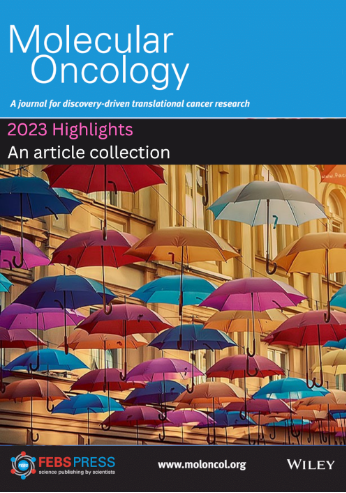肿瘤异质性背景下ERG蛋白的原位表达可识别预后较差的前列腺癌患者
IF 5
2区 医学
Q1 ONCOLOGY
引用次数: 3
摘要
需要前列腺癌症的预后生物标志物来改善疾病过程的预测并指导治疗决策。然而,该疾病常见的多发性和异质性使生物标志物的开发变得复杂。我们旨在确定候选生物标志物转录调节因子ERG和相关ETS家族基因的预后价值,同时考虑肿瘤的异质性。在一个三级中心的多样本、前瞻性和治疗幼稚的根治性前列腺切除术队列中(2010-2012年,中位随访8.1 年),我们分析了ERG蛋白(480名患者;2047个组织核心)和亚群中几个ETS基因的RNA(165名患者;778个新鲜冷冻组织样本)。在29%和33%(ERG蛋白)以及39%和27%(ETS RNA)的患者中分别发现了局部内和局部间异质性。ERG蛋白和ETS RNA分别在31%和32%的非索引肿瘤中被单独鉴定。ERG蛋白在预测生化指标方面具有独立的预后价值(P = 0.04)和临床复发(P = 0.004),并且似乎对4-5级组的患者具有最大的预后价值。总之,当考虑异质性时,ERG蛋白是前列腺癌症的可靠预后生物标志物。本文章由计算机程序翻译,如有差异,请以英文原文为准。
In situ expression of ERG protein in the context of tumor heterogeneity identifies prostate cancer patients with inferior prognosis
Prognostic biomarkers for prostate cancer are needed to improve prediction of disease course and guide treatment decisions. However, biomarker development is complicated by the common multifocality and heterogeneity of the disease. We aimed to determine the prognostic value of candidate biomarkers transcriptional regulator ERG and related ETS family genes, while considering tumor heterogeneity. In a multisampled, prospective, and treatment‐naïve radical prostatectomy cohort from one tertiary center (2010–2012, median follow‐up 8.1 years), we analyzed ERG protein (480 patients; 2047 tissue cores), and RNA of several ETS genes in a subcohort (165 patients; 778 fresh‐frozen tissue samples). Intra‐ and interfocal heterogeneity was identified in 29% and 33% (ERG protein) and 39% and 27% (ETS RNA) of patients, respectively. ERG protein and ETS RNA was identified exclusively in a nonindex tumor in 31% and 32% of patients, respectively. ERG protein demonstrated independent prognostic value in predicting biochemical (P = 0.04) and clinical recurrence (P = 0.004) and appeared to have greatest prognostic value for patients with Grade Groups 4–5. In conclusion, when heterogeneity is considered, ERG protein is a robust prognostic biomarker for prostate cancer.
求助全文
通过发布文献求助,成功后即可免费获取论文全文。
去求助
来源期刊

Molecular Oncology
医学-肿瘤学
CiteScore
12.60
自引率
1.50%
发文量
203
审稿时长
6-12 weeks
期刊介绍:
Molecular Oncology highlights new discoveries, approaches, and technical developments, in basic, clinical and discovery-driven translational cancer research. It publishes research articles, reviews (by invitation only), and timely science policy articles.
The journal is now fully Open Access with all articles published over the past 10 years freely available.
 求助内容:
求助内容: 应助结果提醒方式:
应助结果提醒方式:


